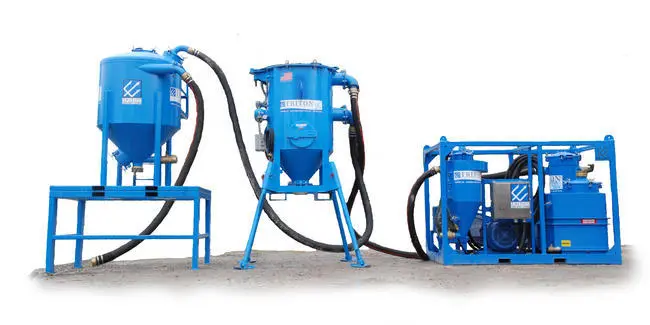Triton’s Liquid Ring Series of vacuum systems requires an external vessel or tank to contain the product that is vacuumed. Triton’s smaller T500 series comes with an onboard collection tank, typically 10 bbl (440 gal) in size. The larger, more powerful Liquid Ring Series (including the T1500, T2000, and T2500) are routinely used to pick up a larger volume of product. Several alternatives exist to allow various application needs to be met. The common characteristic is that the collection vessel or tank must be capable of withstanding a vacuum. There are options, though, for getting the product into an open-to-the-atmosphere container, such as an open-top rolloff.
A popular option for many products is a vacuum box. A “vac box” can be winched on/off a rolloff truck for transport. A standard vac box is 20 or 25 cubic yards, and the design is air-tight. Typically, a vac box has two flanges with 8” male threads on opposite ends, one each for inlet and outlet. The working end of the hose is fitted to the inlet. The outlet connects to the vacuum source. Fittings and adapters are available to neck down to 6” or 4” size hose if needed. There is often a 4” drain flange on the lower part of the box as well. Vac boxes are available that have a dump door in the rear, so that product can be discharged by gravity if desired. Triton does not offer vac boxes, but they are widely available for rental from several vendors. The operator must manually monitor the product level in the vac box, and product specific gravity must be considered so that the box is not filled above legal over-the-road weight limits.
For collecting drill cuttings in offshore oil production applications, as well as handling many liquids and solids, a “cuttings box”, or “skip”, is used. A cuttings box is often sized for 25 bbls, is compact, stackable, meets DOT standards, and has certified lift eyes to allow movement by cranes so that it can be lifted off the rig and onto a barge for transport. A special lid is used to allow product to be pulled under air-tight vacuum. Typically, a single lid is shared between boxes. Again, product fill levels must be monitored and the lid must be moved to a new box. Coordination is necessary to avoid delays and keep production going.
Another alternative for product collection is a cone-bottom collection tank. Triton’s Collection Tanks are elevated on a stand so that supersacks, drums, or open top rolloffs can contain their discharge through a bottom dump valve. A standard tank size might be 475 gals (64 cubic feet). Collection tanks are often used as the first step in a process to recover solids products such as abrasive blast media, sand, grain, or cement dust. As with other collection vessels, there is an inlet and outlet fitting. The outlet hose is connected to the dome lid fitting on the tank. The working end of the hose is connected to a side inlet fitting. That configuration allows the air to convey the product into the tank, where a cyclonic effect and gravity cause the product to fall out. The air stream exits the top of the tank toward the vacuum source. A product flyer is available describing Triton’s Collection Tanks, which also include horizontal tanks.
(Solids Recovery Package: from left-to-right, Collection Tank, Baghouse, Vacuum Unit):

A separate concept is to pull product into a vessel where it can be pumped off. This is the concept used in Triton’s patented Kraken technology, as well as in Triton’s Drop Tank and Triton’s Dual Cyclone Loader. The Kraken allows continuous discharge of sludges and liquids via synchronization with the vacuum system. Triton’s Drop Tank has double diaphragm pumps to allow fluids to be pumped off in a batch-wise fashion. The Triton Dual Cyclone Loader maintains continuous vacuum pull while allowing the product to be discharged via gravity into a separate process or container. Additional information is available from Triton on these unique collection-and-discharge systems.
Dual Cyclone Loader (left) and Drop Tank (right):

Click here is you’d like a downloadable pdf of this content. And please contact us for more information!





